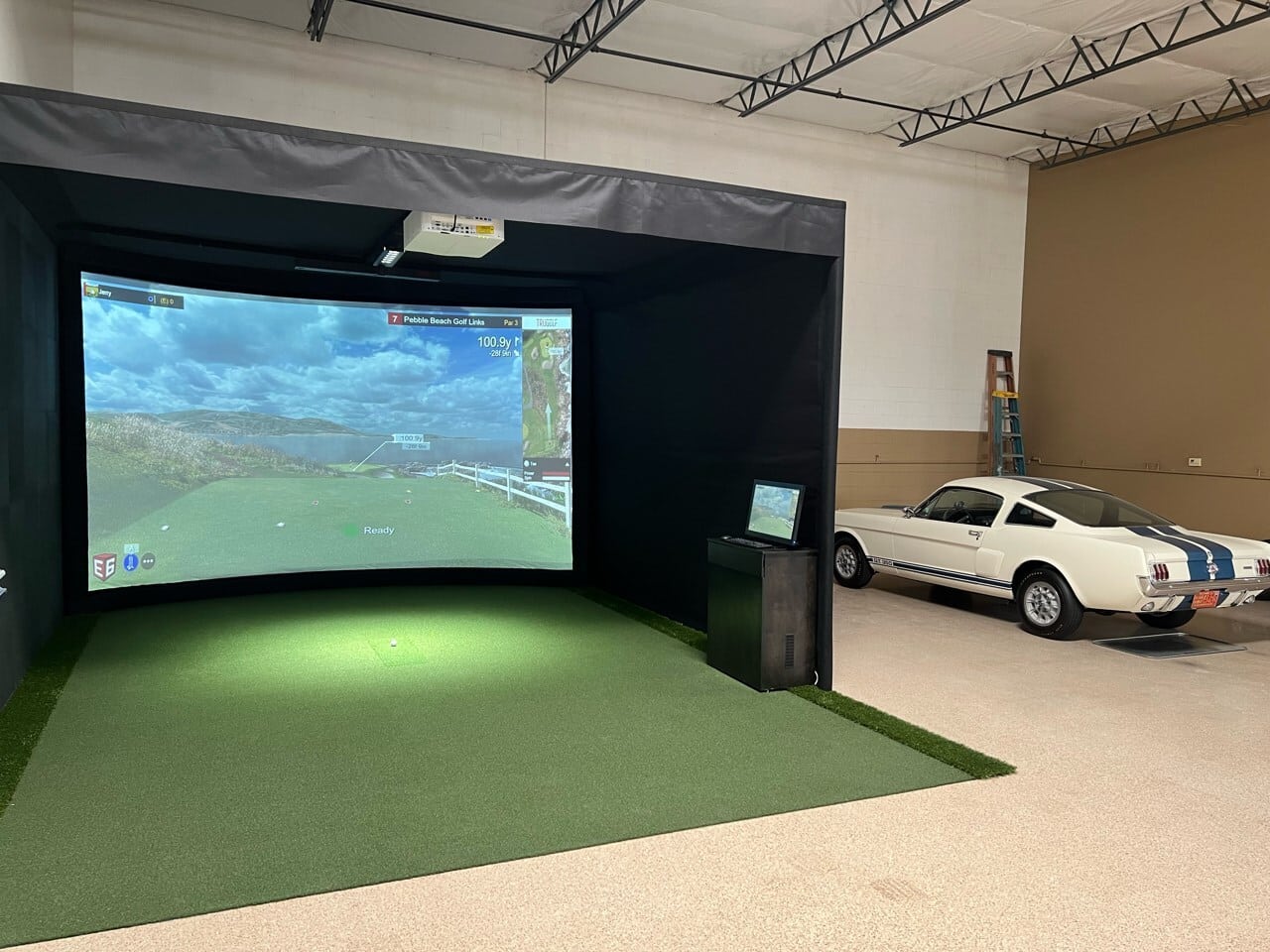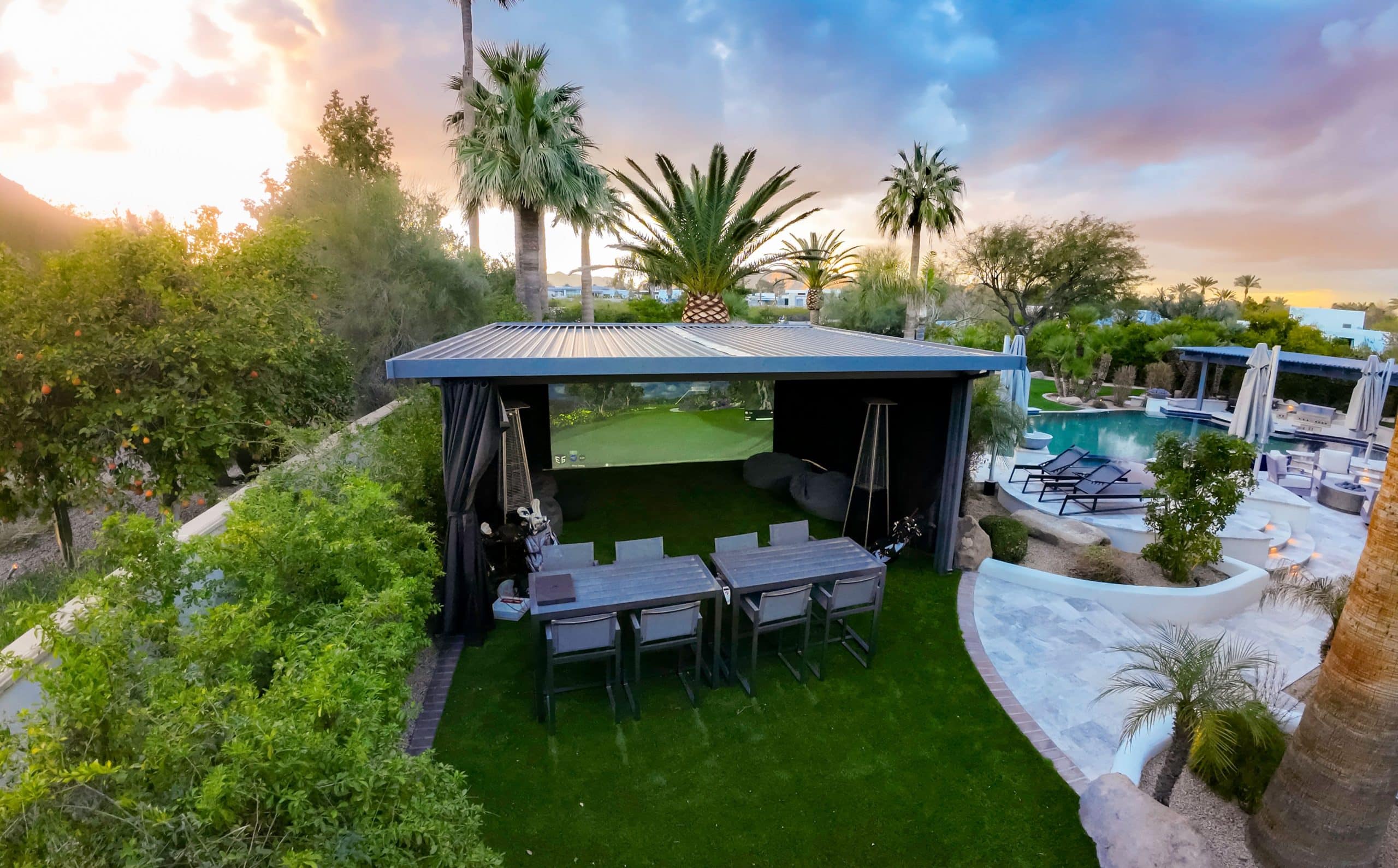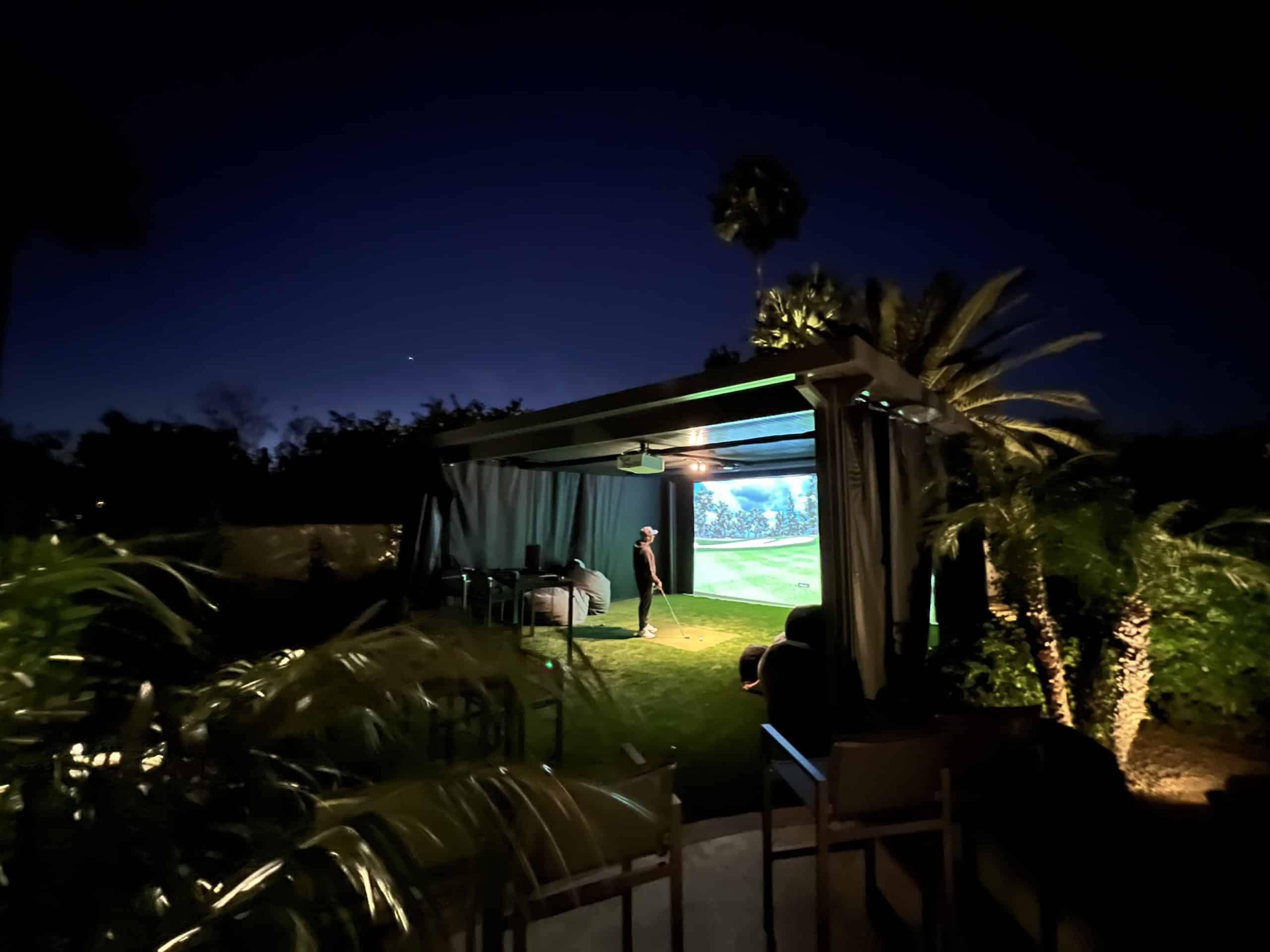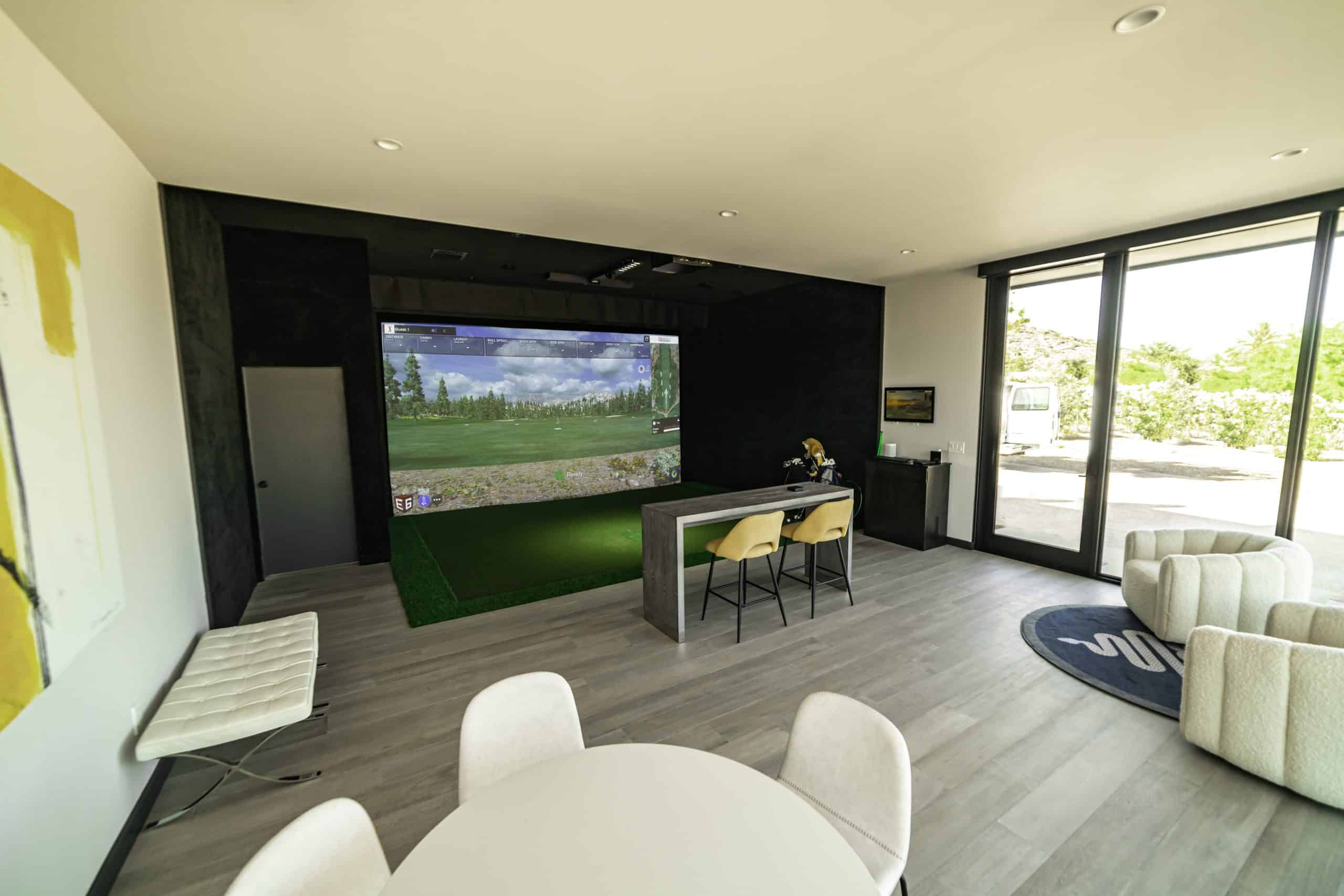The 16:9 aspect ratio creates the most realistic golf simulator experience because it matches your natural horizontal field of view, making virtual courses feel authentic. You'll want a 13x7.7-foot screen if your room allows it, though 4:3 ratios work better in narrow spaces since they provide extra vertical clearance for your swing. Your room needs 14-16 feet of width for 16:9 setups and at least 9-10 feet of ceiling height for safe driver swings. Keep exploring to uncover how room dimensions determine your perfect setup.

When you're setting up a golf simulator, the aspect ratio of your screen might seem like a minor detail, but it's actually one of the most crucial decisions you'll make for your setup. The key point is: your screen's width-to-height ratio directly impacts how realistic your virtual golf experience feels.
The three main options you'll encounter are 16:9 (widescreen), 4:3 (more square), and 16:10 (less common middle ground). Each ratio affects your visual immersion differently. A 16:9 screen matches your natural horizontal field of view, making virtual courses feel authentic. Meanwhile, 4:3 screens optimize vertical space, giving you more swing clearance. Choose wrong, and you'll deal with image distortion or wasted screen space that breaks the illusion of being on an actual course. However, prioritizing maximum screen size over perfect aspect ratio matching often delivers superior immersion since modern projectors can adapt to display various ratios effectively.
For the best visual quality, it's recommended to project at your projector's native aspect ratio to avoid any unwanted black bars or image stretching that can diminish your playing experience. Generally, it's recommended to get the largest screen that fits in your area, as larger screens enhance the viewing experience and provide better immersion, similar to how larger TVs improve your entertainment experience.

Your screen's aspect ratio choice is only as good as the room you're putting it in. A 16:9 widescreen format demands at least 14-16 feet of width, while a narrower 4:3 screen can squeeze into 10-12 feet. The main point – you'll need 18-20 feet of depth for ideal projector placement, though 15 feet works as your bare minimum. Your ceiling height can't be negotiable either; 9-10 feet keeps your driver swing safe from disaster.
Wider rooms offer immersive widescreen experiences, but they come at a higher cost. Narrower spaces work fine with traditional formats, just expect a more confined feel. Don't forget to include a buffer space of at least 2 feet on either side of your enclosure for safety and movement. Reserve at least seven feet of unobstructed space behind your tee area to accommodate full backswings without interference. For TrackMan users specifically, this seven-foot distance also enables proper positioning of the radar unit for accurate shot tracking. The sweet spot? Plan your projector distance initially, 12-16 feet from the hitting area – then work backward to determine which aspect ratio fits your available space.
Size matters in relation to golf simulator screens, and going too small will kill the immersion you're after. You'll need at least 7.5 to 8 feet of height for comfortable wedge shots, though 9 feet is better if your room allows it. The important point is: anything under 6 feet tall won't cut it for realistic golf experience.
For width, you're looking at 12 to 14 feet minimum to create that true golf course feel. A 13x7.7-foot screen (16:9 ratio) delivers solid immersion in most moderate-sized rooms. If you've got width constraints under 14 feet, consider a 4:3 aspect ratio—it gives you extra vertical height without eating up horizontal space. Your projector's throw distance will need to accommodate these dimensions, typically ranging from 10 to 15 feet for optimal setup. Tall golfers specifically benefit from the additional ceiling height to ensure proper swing clearance. The screen material's weave density plays a crucial role in maintaining sharp visuals across these larger dimensions while handling high-speed ball impacts. Remember, you need proper viewing angles and swing clearance to make it work!

Getting your projector, launch monitor, and screen to play nicely together isn't as simple as plugging everything in and hoping for the best. The fact is: most high-end projectors come with native 16:9 aspect ratios, supporting crisp 4K (3840×2160) resolutions. But your golf simulator screen might be 4:3 or even 1:1 for space reasons.
You'll need to create custom resolutions through your graphics card settings. For example, convert that 4K 16:9 signal to 2880×2160 for a 4:3 screen. NVIDIA and AMD control panels make this surprisingly straightforward with step-by-step wizards. Custom resolutions enhance pixel density while minimizing distortion, ensuring you get the sharpest possible image quality. Modern projectors with integrated cameras can automatically adjust images based on your screen's actual aspect ratio, eliminating manual calibration headaches.
Your launch monitor doesn't care about aspect ratios—it just feeds data to the software. The real compatibility dance happens between your projector's native output and your screen's physical dimensions. Golf simulators require higher brightness than standard home theater setups, with 3000 ANSI lumens recommended for smaller screens and 4000 lumens or more for larger installations.
Regarding nailing the perfect aspect ratio for your golf simulator, the 4:3 format emerges as the clear winner for most home setups. Here's why it works so well: you'll get the greatest vertical height, which perfectly matches your natural swing plane and eliminates that cramped feeling.
While 16:9 screens offer more width, they often create annoying black bars above and below the golf course image. That unused space breaks your immersion and wastes precious screen real estate. The 4:3 ratio fills your entire visual field during play, maintaining focus on the projected environment. Modern launch monitors track essential data like club head speed and ball spin rate regardless of your chosen aspect ratio, but proper screen proportions ensure you see all that valuable feedback clearly.
Your room dimensions matter too. If you've got limited width but decent ceiling height, 4:3 optimizes screen size. Plus, most simulator software renders natively in 4:3, ensuring top-notch image quality and brightness distribution. When measuring your space, remember to identify obstructions like light fixtures or air vents that could affect your screen placement.

Yes, you can absolutely use curved screens with different aspect ratios! Unlike flat screens with fixed ratios like 16:9, curved golf screens offer flexible customization. You can adjust the aspect ratio to fit your room dimensions and desired immersion level. Popular choices include 16:10 for wider views. Just make sure your projector's compatible and can properly map images without distortion across the curved surface.
Ambient light washes out your projector's image by raising black levels, making everything look gray and dull. You'll want a taller aspect ratio in bright rooms because wider screens catch more ambient light reflections. The point is - if you can't control room lighting, consider a 4:3 or 16:10 ratio instead of ultra-wide formats. Ambient light rejection screens help, but narrower screens still perform better in general.
You'll typically pay 20-50% more for 16:9 screens compared to 4:3 screens of similar height. Entry-level 4:3 impact screens start around $200, while 16:9 screens begin at $300-400. Premium setups really show the gap—high-end 4:3 screens max out around $2,000, but comparable 16:9 screens can hit $5,000+. The wider dimensions require more material and stronger impact-resistant fabric, driving up costs considerably.
Yes, professional golf instructors definitely prefer wider aspect ratios like 16:9 or even 21:9 for lessons. Here's why: these ratios let them capture your entire swing path, stance, and follow-through without cropping anything significant. You'll get better feedback because instructors can see your body movement and ball flight simultaneously. Plus, wider screens mimic natural human vision, making swing analysis way more accurate and effective.
You can definitely change aspect ratios without replacing your projector! Most modern projectors support multiple formats like 4:3, 16:9, and 16:10 through their menu settings. Your graphics card can also output custom resolutions to match different screen sizes. However, here's the catch - you might see some image quality reduction if you stray too far from your projector's native aspect ratio.
You've got the blueprint now, choose your aspect ratio based on your room size, budget, and what feels right when you're standing there with a club in hand. Remember, a 16:9 screen that's properly sized beats a massive 4:3 that cramps your swing space. Test different setups if you can, trust your gut, and don't overthink it. The perfect simulator is the one you'll actually use every day!